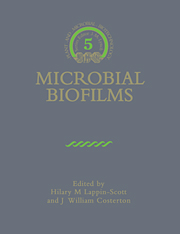Book contents
- Frontmatter
- Contents
- List of Contributors
- Series Preface
- Introduction to Microbial Biofilms
- Part I Structure, Physiology and Ecology of Biofilms
- 1 Growth of Microorganisms on Surfaces
- 2 Dynamics of Bacterial Biofilm Formation
- 3 Cultivation and Study of Biofilm Communities
- 4 Genetic Responses of Bacteria at Surfaces
- 5 Biochemical Reactions and the Establishment of Gradients within Biofilms
- 6 Mechanisms of the Protection of Bacterial Biofilms from Antimicrobial Agents
- Part II Biofilms and Inert Surfaces
- Part III Biofilms on the Surfaces of Living Cells
- Index
2 - Dynamics of Bacterial Biofilm Formation
Published online by Cambridge University Press: 24 November 2009
- Frontmatter
- Contents
- List of Contributors
- Series Preface
- Introduction to Microbial Biofilms
- Part I Structure, Physiology and Ecology of Biofilms
- 1 Growth of Microorganisms on Surfaces
- 2 Dynamics of Bacterial Biofilm Formation
- 3 Cultivation and Study of Biofilm Communities
- 4 Genetic Responses of Bacteria at Surfaces
- 5 Biochemical Reactions and the Establishment of Gradients within Biofilms
- 6 Mechanisms of the Protection of Bacterial Biofilms from Antimicrobial Agents
- Part II Biofilms and Inert Surfaces
- Part III Biofilms on the Surfaces of Living Cells
- Index
Summary
Introduction
Biofilm formation is important in a wide variety of situations: for instance, colonization of pipe surfaces in the food and water industries, metal corrosion due to sulphate reducing bacteria in the shipping and oil industries, and in medicine associated with infections of various tissues (osteomeylitis and endocarditis), dental decay (Addy et al. 1992) and prosthetic implants (Dougherty 1988). Whereas biofilm formation in a chemostat is considered merely an operating nuisance (Bryers 1984), in industrial fermentors such fouling can cause physical damage by the production of metabolites at points on the surface. Biofilms may lead to reduced heat efficiency transfer and reduction in flow rates, and can also act as a resevoir for potential pathogens (Lappin-Scott & Costerton 1989).
Although biofilm formation is frequently associated with being harmful and detrimental, in many instances it can also be beneficial. Biofilms are used in wastewater treatment for the degradation of soluble organic or nitrogenous waste. In nature microbial decomposition of cellulose fibres requires prior attachment of cellulolytic bacteria and Rhizobium cells form biofilms on the roots of leguminous plants where nodules are formed to fix atmospheric nitrogen. Bar-Or (1990) stated the importance of biofilms in stabilizing soil either by acting as cementing agents or flocculating soil particles, thereby improving aeration and water percolation and allowing further microbial growth.
Biofilm formation is difficult to control. A number of authors have reported that biofilm bacteria (sessile) are more resistant to antimicrobial agents than suspended bacteria (planktonic) of the same species (Brown et al. 1988; Anwar et al. 1989). Most commercial biocides and antibiotics were developed and tested for their ability to kill planktonic bacteria (Chopra 1986; Gilbert et al. 1987).
- Type
- Chapter
- Information
- Microbial Biofilms , pp. 46 - 63Publisher: Cambridge University PressPrint publication year: 1995
- 34
- Cited by



